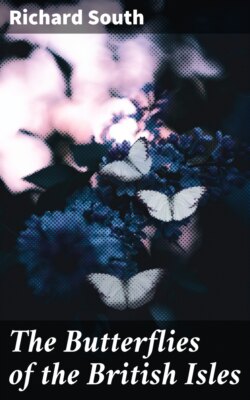Читать книгу The Butterflies of the British Isles - Richard South - Страница 17
На сайте Литреса книга снята с продажи.
The Small White (Pieris rapæ).
ОглавлениеTable of Contents
The Small White butterfly (Plate 11) is, perhaps, more often in evidence then its larger kinsman just referred to. It also is a migrant, and although it never seems to be absent from these islands, in its proper season, its great increase in numbers in some years is almost certainly due to the arrival of immigrants.
The spring form of this butterfly, named metra by Stephens, who, together with others, considered it a good species, has the tips of the fore wings only slightly clouded with black; and the black spots near the centre of the wings are always more or less faint in the male. Sometimes the central spot and also the blackish clouding of the tip are entirely absent. The summer brood, on the other hand, has fairly blackish tips and distinct black spots—one in the male and three in the female, the lower one lying on the inner margin. Occasionally examples of this flight bear a strong resemblance to the Green-veined White, the next species. The wings are sometimes, chiefly in Ireland, of a creamy colour, more especially in the female, or, more rarely, of a yellowish tint. In North America, where this species was accidentally or intentionally introduced some years ago, bright yellow forms are not uncommon in some localities, and the variety is there known as novangliæ.
In certain favourable years a partial third brood has occurred, but such specimens are often small in size.
The egg (Plate 8) is at first pale greenish, but later on it turns yellowish, and this tint it retains until just before the caterpillar hatches out.
The caterpillar when full-grown has a brownish head and a green body; the latter is sprinkled with black and clothed with short blackish hairs emitted from pale warts. There is a yellowish line on the back, and a line formed of yellow spots on the side. It feeds on most plants of the cabbage tribe, and in flower gardens on mignonette and nasturtiums. It is often attacked by parasites, and especially by the Apanteles, referred to as destructive to caterpillars of the Large White.
The chrysalis may be of various tints, ranging from pale brown, through grey to greenish; the markings are black, but these are sometimes only faint. It is to be found in similar situations to those chosen by the caterpillar of the last species, but often under the lower rail of a fence or board of a wooden building. Where caterpillars have been feeding in a garden, they often enter greenhouses, among other places, to pupate; and where these structures are heated during the winter, the butterflies sometimes emerge quite early in the year. Distributed throughout the British Islands, except the Hebrides and Shetlands. It is common over the whole of Europe, and extends through Asia to China and Japan. In America, where it was introduced into the United States some forty-five years ago, it has now spread northwards into Canada, and also southwards.
